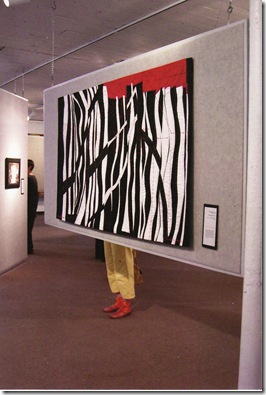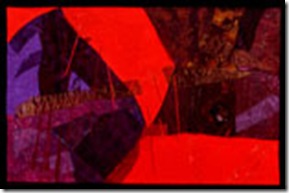 don’t you just love quilts with legs!!! I’m so sorry I don’t remember who gave me this photograph ( I wasn’t at the opening) but I have enjoyed it so much so many thanks to you again. And it wasn’t easy attaching those legs I’ll tell you!
don’t you just love quilts with legs!!! I’m so sorry I don’t remember who gave me this photograph ( I wasn’t at the opening) but I have enjoyed it so much so many thanks to you again. And it wasn’t easy attaching those legs I’ll tell you!Anway back to the topic: about 25% of the quilts included in those two shows were fairly straightforwardly pictorial. 38% were grid based. About 11% were strip based (another traditional way of composing a quilt). So if you add those two together almost half of contemporary quilts (as represented by those two shows) have their roots firmly in very traditional formats.
Looking at the remaining 25% about 10% were overall surface design techniques (not pictorial). the other 15% were were a variety of different things but mainly abstracted pictorial work (where I would classify myself usually), or free form organic organizations like those that Dominie Nash does. This one below is from her Red Landscape series.

There were,of course,many variations upon the grid - some were definitely just rows of blocks, or rows of blocks slightly off kilter, or sectioned up into slightly different shaped blocks. Some were based upon a much larger section of a grid being composed of a few large geometric shapes - like a long wide rectangle with 3 squares beneath.
But, by far the most common way of interpreting the grid(after the traditional rows and columns variety) was what I’d call the layered grid: Squares and rectangles cut out and layered upon each other. This often yielded a rather asymmetrical grid.
I noticed that even if the quiltmaker had begun without a grid - say for example an overall painted surface - then quite frequently a grid(in paint, or stitching or even applique) was overlaid to organize the shapes beneath.
Some people composed the other way round, beginning with a grid and then adding elements on top.
And others were clever in lining up squares to lose the edges and thus hide sections of the grid. A neat trick because it makes you peer in and see what happened!
I wonder if the p0pularity of the layered grid occurs as a result of the very common process of cutting out pieces of fabric freely and then positioning them on the wall “intuitively” i.e. without thinking about them too much but instead arranging them in a way that “feels right”. When we cut out pieces of fabric free form I think we would naturally cut fairly organized shapes. And then, in grouping them on the wall, we would aim for some kind of balance - two single pounds on this side of the scale, one larger bag containing two pounds on that side as it were.
I think we have a natural inclination to want to put things into rows and balance them up. I remember when I was a child one of my favorite activities was to crawl under the rose bushes in the park to some old flagstones collecting dropped (usually,but alas, not always!) petals on the way and then organizing them on the square flags in rows and columns. I saw a beautiful show of Sue Lawty’s work (Google her name for lots of images)at the V&A some years ago where she had chosen tiny pebbles from the shore and glued them in precise rows onto canvases; the result looked like epistles in a mysterious stone language.
I don’t know if there is quite the same preponderance of grid based abstract designs in art that does not have a textile connection, but I don’t think so. Not that grids don’t appear, they do: Klee, Scully, Close etc etc, but not, I think ,to the same extent as we see in contemporary art quilts.
So I wonder…
Are we hard wired to grid?
Is this an archetypal memory surfacing when we work intuitively?
Or is it the result of a basis in traditional quilting that so many of us have? (I would think this is at least a factor for I’ve noticed that those quilters whose work is least grid based tend to the those with less of a traditional background, and vice versa).
So, what do you think? Are you a grid person, or not? D’you find yourself unconsciously falling into a grid state? We are more creatures of habit than ever we would admit!
and, if you have been, thanks for reading! Elizabeth
PS and thank you for all the encouragement to continue to cogitate and witter about said cogitation! Much appreciated!
















15 comments:
You know I definately think I'm a grid person - I'm not sure if its because traditional quilts have always been on my bed or that my education has been filled with grid after graph after grid - but I do like the predicable nature of them. I even have a sketch book that has a light grid on it - Now that said - its REALLY fun to go against the grain - oops - I mean grid. So I do try do that on occassion.
I've thought on this a lot with the notion of wanting to get clear of the grid but the very composition of cloth, warp & weft, seems to set the mental tone.
Right angles are in the nature of what cloth likes to do, ripped or folded, and we are hard put to argue with what comes naturally. The arguing itself goes against the that old tactile comfort factor, another reason why we pick up and engage with cloth in the first place.
I'm fascinated by grids but they have so many varieties other than the sqaure ones - wiggly, off-kilter, asymmetric, based on a variety of geometric shapes and so on...
Coming from a traditional background, I worked hard to get out of a grid when I wanted my work to be more original.
I finally put away the grids and paper patterns when I discovered I could make more natural looking images that way.
A grid can be an easy way to give order and structure to nonfigurative work.
I think it goes far beyond the grid in traditional quilts. We are conditioned by grids on buildings in the form of windows/doors, grids on maps, grids formed by books on shelves, grids on pavement, grids... well, everywhere. The development of photography started exposing us to grids in the form of photo sheets and photo albums and.... I don't think anyone can escape some gird influence, no more than they can escape the visual image of December as Xmas, September as back to school, February as hearts and cupids, etc. We are conditioned to these things from a very early age. [The word is dinil.]
I do like Deb's idea that the grid is related to the structure of the fabric itself, so cutting and sewing it into a grid is like a mega fractal!
There's no doubt about it grids are satisfying and stable as well as restrictive!
I think you'd have to go back about 10 years to find anything resembling a grid in my work. I tend to be one of those people who are not into symmetry. Which may explain the lack of the grid. Don't know. Check out my work and let me know if you see a grid in it.
http://www.marnigoldshlag.net
I found myself pleased that a large percentage of those quilts were rooted in quilting's traditional background. But at the same time I think some of that interest in the grid may be related to all the straight lines in our world--houses, building of all kinds, fences, roads, even, oftentimes, the horizon. I think that, as humans navigating through the world, we use lines as referents, then relate one line to another. So I'm agreeing that grids, or at least lines, may indeed be hard-wired. Fascinating. Thank you for your assessment of the QN works.
I'm in the hard-wired to grid camp. Grids mean organization and humans love to organize things. I studied graphic design and the grid was the basis of practically everything. It helps us to organize and to balance elements.
I am not a grid person but it naturally happens because we sew seams which are generally straight seams. I much prefer straight seams to curves which can look even more artificial. I also think people like grids because it looks orderly.
Marti
I have not been making grids in textiles for years, and actually have moved away from textiles to oil painting for the last five. When I was learning the art, I did grids, but quickly found myself leaving them behind.
That said, I now have a deadline for a couple of textile pieces coming up and I'm suddenly doing blocks on grids. I think I agree with Deb (and Elizabeth); the nature of the weave and the way it tears (I've returned to tearing rather than cutting)tends to push us in that direction. And then there's the whole weight of tradition.
But I am bemused to find myself back into a somewhat (only somewhat, of course) traditional mode. I'm one of those who didn't come from a quilting background, so my retreat isn't linked to old habits. I have always maintained, though, that quilted textiles are the perfect medium for abstract work. I can do abstraction in textiles in a way that I find really difficult in oils.
Go figure -- the mysteries of art making, media, mind, matter, material and mucking about.
I come from traditional quilting and have difficulty getting out of the grid.
My grandmother likes grid based abstract quilts. She usually choose fabric with red and white hues. I remember her making grid based quilt in her sewing shop. Flags, ribbons and table mantles are her favorite sewing projects. That's why my friends used to shop flags in her shop.
Post a Comment